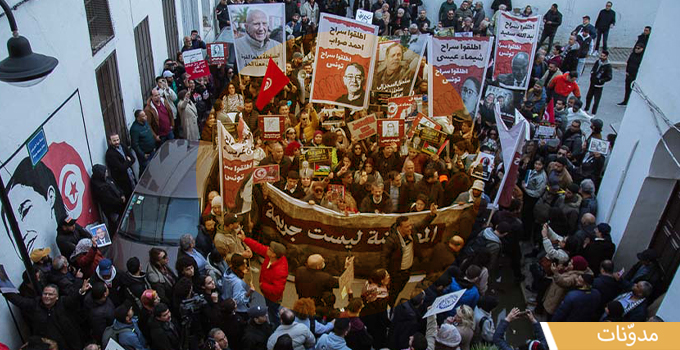A few weeks ago, I presented here in Nawaat a model predicting the outcome of the parliamentary elections. The study was accurate in predicting the ranking from the elections but I predicted a narrower gap between Nidaa Tounes and Ennahdha than what came out of the elections (4% vs. 10%).
Now, on the eve of the presidential elections, I am at it again and I am presenting my forecast for the first free presidential elections in the history of Tunisia.
The model has three major steps to get the final forecast. First, we try to aggregate all available surveys and opinion polls, which will be weighted according to the credibility of the survey. Then we distribute the undecided votes among the various presidential candidates. There have been 45 presidential polls since elections in October 2011 with the majority of studies conducted by 3C surveys Sigma Council Emhord Consulting and the International Republican Institute. The evaluation criteria surveys are: 1 the sample size or number of respondents, 2 the date of the survey, and 3 the reliability of the organization or institution that led the survey.
Step 1: Determining optimal weights for each poll
1. Assessing the credibility of pollsters:
This is measured by looking at the accuracy pf their polls. The only historical references are the Tunisian parliamentary elections of 2011 and 2014. Given that 2011 is pretty old and there were only 7 polls prior to the elections we hence focus on the 2014 elections.

2. Polls Accuracy with
As expected, the polls are more accurate with the upcoming elections. On average, the accuracy of the surveys (as measured by the sum of the individual errors for each party, calculated absolute value) improved by 0.9% monthly. However, we also find that the accuracy of polls is not correlated with the sample size, which is not very intuitive. Hence, we did not apply any weight to opinion polls sample size. We did however apply a higher weight to more recent polls.


Step 2: Adjusting and weighting polls


Step 3: Allocating Undecided Voters
The most difficult step in the process is the distribution of votes of the undecided to the various parties and adjusting predicted votes. After weighting, we found around 55% undecided. Again, the historical reference is the parliamentary elections of 2014.
Step 4: Incorporating results of 2014 parliamentary elections
The parliamentary elections that Nidaa Tunes clearly won with 37.2% of the votes and 39.6% of the seats respectively provide us the information and the freshest and tangible evidence of the results of presidential elections.
The legislative show that the Tunisian electorate rejected by a clear government troika way and punished severely allies of the government Ennahdha, CPR and Ettakatol.
The results are highly relevant laws to predict the outcomes of presidential preferences since voters do not change much in a month. In this sense, the very small time delays (27 days) between the legislative and presidential elections favor parties that performed well during the legislative and not allow the voter to reassess the political spectrum.

To finalize the forecast, I average out the outcome of the parliamentary elections and the weighted polls to come up with a single prediction by candidate.
So my final projection is that BCE well ahead with 43% of votes, followed by Moncef Marzouki, second with 23% of votes. Hamma Hammami finishes third with 8% of the votes. The margin of error (with a confidence interval of 95%) is +/- 3.1%.
Hence, I predict a run-off in December between BCE and Moncef Marzouki.

This study obviously has several limitations. On the one hand the limited democratic experiment in Tunisia provides us with a small number of surveys and only two historical elections to estimate the reliability of the organization or company that conducted the survey, the effect of sample size or the proximity of elections. Then, the most recent survey of July 2014. Finally, there is a great inconsistency in technical surveys.





To clarify, Ennahdha did not officially endorse any candidates but I think that we can safely assume that Marzouki will pick up a good percentage of Ennahdha’s vote
Dear Moez,
I think you’ve got the ranking right even though, in my opinion, your calculations over estimate BCE’s score. Within NIDAA, I would say that there is a group of hard-core voters who will vote for BCE in any situation. But, there are also voters who did vote for NIDAA during the previous time, but they will go for another candidate this time. So, my own prediction is that BCE will get, at most, 40%. Of course any result would be heavily dependent on the participation rate, which is to this hour, relatively low.
Best,
Dear TunEconomist,
your argument could be correct but unfortunately it is an effect that is difficult to measure and for which there are no tangible data (exit polls or post-parliamentary elections polls) to refer to. The counter argument is that voters preferences typically do not change a lot in on month and Beji is likely to recoup whomever voted for him in the parliamentary elections. well, we’ll know very soon
Best,
Moez
Dear Moez,
Well, it seems that my own nonparametric model did OK :)
Seriously, I really do appreciate this kind of analysis which is mainly based on numbers and facts with zero bullshit.
Please, keep ’em coming.
Best,